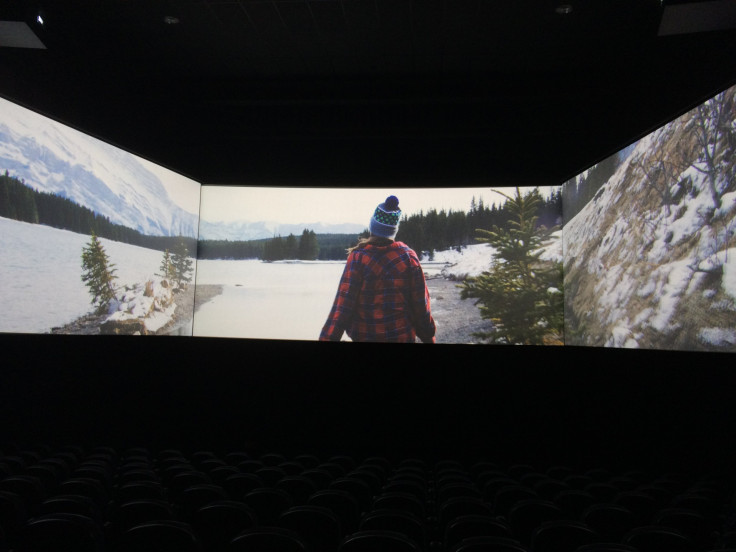The Movie Theater Of The Future Is All About Big Screens And Big Data

LOS ANGELES — What will a night at the movies look like in a few years? Bigger screens and Bigger Brother.
With huge-flat screen TVs becoming more affordable — and more original TV content being produced — cinemas have to step up their game to keep pace in the arms race with home theaters. That’s why theater chains are coming out with better food, reclining chairs, and more supersized screens like Imax to take full advantage of the special effects in many tentpole blockbusters.
But what’s even cooler than one big screen? Three of them. And we should see a lot more of that soon.
Thursday afternoon, the Regal: L.A. Live cineplex at the L.A. Live entertainment complex in downtown Los Angeles unveiled what execs called the “most technologically advanced” movie theater in the world. The theater, which opens to the public Friday night, now has a lobby that’s part of the show (and soon, a camera-based audience data gathering tool to go with it), and a cinema equipped with the showpiece Barco Escape, which combines three screens in a U-shaped pattern that gives the viewer almost a cockpit-type perspective of the action. Barco is a Belgian company that’s one of the largest manufacturers of digital cinema hardware in the world, and several execs from the company — along with those from Regal and L.A. Live owner AEG — were on hand to demonstrate the technology.

“The Maze Runner” and its sequel, “Maze Runner: Scorch Trials,” were the first — and only — two films with scenes optimized for Barco Escape, but with dozens of Imax films coming out every year, there needs to be a much broader pipeline of content to compete with other large formats. Todd Hoddick, chief executive of Barco Escape — which is a standalone company under the Barco umbrella — said that was a key driver behind getting a Barco Escape setup in the heart of downtown Los Angeles, where screenwriters can get familiar with the medium. Hoddick said the company has already demonstrated the technology for more than 200 creators and studios, and director Scott Waugh is currently working on the first feature-length film designed specifically for Barco Escape.
Hoddick said he wants to develop three additional films this year, then eight in 2017 and then 12 a year after that. The company will need that content to justify the number of Barco Escape theaters it wants to open. The Barco Escape costs exhibitors $100,000 with an additional fee per movie. When not in use, the side screens can be concealed behind curtains to allow the theater to be used for movies with a conventional aspect ratio, but theaters aren’t going to pay to install the three-screen system just to hide two-thirds of it most of the time.
With the addition of L.A. Live, there are currently 21 Barco Escape theaters in the world — 16 in the United States, two each in Europe and China, and one in Mexico. Hoddick said the plan is to have more than 100 by the end of this year, and 1,000 within three to five years. Oh, and they want an additional 1,000 just in China, soon to be the world’s biggest movie market — and one where Imax is in the process of opening hundreds of its own screens.
Hoddick said while Barco Escape is only for 2D films at this point, he imagines it’s only a matter of time before 3D comes to the platform. And while it’s currently about 4 percent more expensive to produce a movie for Barco Escape, because the work has to happen in post-production, Hoddick said new cameras from manufacturers including Sony that can film in the 7:1 aspect ratio necessary for the medium will slash costs significantly.
But before moviegoers and creators can get hooked on watching movies on three screens, they have to walk through the front doors. And if the lobby at the L.A. Live theater is a harbinger of what’s to come, the lobby will no longer be a place mostly associated with corny dioramas and ugly carpeting. Barco Lobby Experience broadcasts custom 20-second movie trailers across more than 20 screens, from the entrance hallway to the concession stand, complete with synchronized light and sound displays.

However, that additional content in the lobby has another purpose. Greg Patrick, the Barco exec in charge of Lobby Experience, said the theater will soon install a camera-based surveillance system to analyze demographics and customize which “lobby dominations” go live — think superhero trailers going up when a crew of high school kids walks in. It will also create heat maps to see where in the lobby customers congregate during those dominations. Maybe they’re lingering by the concession stands a little longer — or are even buying advance tickets to a movie.
“We can measure audience demographics for targeted promotions,” Patrick said.
Pressed on what exactly that means in a private interview, Patrick said the system merely converts snapshots of customers to data points (for instance, he himself would be classified as a generic middle-aged white male) to deliver content that will make the people in the lobby at that moment in time come back and spend more money. He said there’s absolutely no plan to identify and target particular people who walk in.
“The data collected is not specific to individuals, and there’s no retention of video,” Patrick said. “It’s all 0’s and 1’s, basically.”
That will hardly reassure everyone, but in 2016, it was probably just a matter of time before big data went to the movies. At least it will know when the concession lines are too long.
© Copyright IBTimes 2024. All rights reserved.





















